How To Choose The Best Cannabis Grow Lights
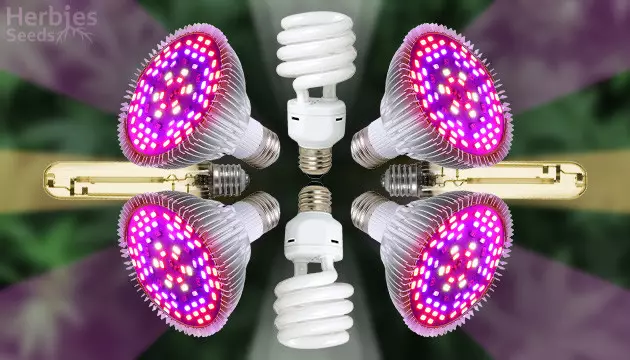
They say you are what you eat. And it’s true — for people and for plants!
While we humans need nutritious food, plants generate energy in a different sort of way: with light. And the best way to care for your cannabis plants is by providing them with the best possible grow lights.
That’s why this article will be diving deep into the best types of grow lights available. As the cannabis industry expands, there are more and more quality options, with some of today’s lights putting out nearly as much light as the sun — meaning happier plants, larger buds and bigger yields.
Many Lights, Many Possibilities
The most common types of grow lights today fall into a few different categories, all with their own strengths and weaknesses. Before getting into the details, here’s the list:

- Fluorescent Grow Lights
- CFL | Compact Fluorescent Lights
- T5 Grow Lights
- HID | High Intensity Discharge
- MH | Metal Halide
- HPS | High Pressure Sodium
- CMH | Ceramic Metal Halide
- LED | Light-Emitting Diode
- Tons of variety…
- ...which makes categorization tough
The Role Of Fluorescent Grow Lights
Fluorescents come in many shapes and sizes. Think of them as the tried-and-true choice — even Thomas Edison worked with early fluorescent lights! They’ve been used both commercially and in home gardens for decades.
They’re also one of the most energy-efficient types of lights out there. That’s a huge plus for large-scale growers looking to keep their expenses down. However, fluorescent lights do have some drawbacks. Their light’s spectrum doesn’t emulate the sun as well as some other options, which means they may not be ideal for flowering plants. If used all the way through until a plant’s in flower, for example, they’ll only yield ¼ gram per bud for every watt of energy spent.
Besides the more obvious difference between CFL and T5 fluorescents (each described in detail further in the article), one of the crucial characteristics in choosing a fluorescent light for the optimal growth and development of cannabis is the plant’s changing need for certain light spectrums during different stages of maturity.

Vegetation: blue spectrum (6400K) required. Vegetative growth occurs even with weaker (400–600μmol/m²/s), shorter-wavelength (400nm) light.
Flowering: red spectrum (2700K) required. Flowering growth depends on stronger (600–1500μmol/m²/s PPFD), more infrared (580-700nm) light.
As a single fluorescent light isn’t capable of providing the full spectrum of light similar to what cannabis would receive in the open, it means you need to ensure the stable growth of your plant throughout the whole cycle by using at least two of them – red spectrum for flowering and blue spectrum for vegetation. Also, keep in mind that there are two types of fluorescent grow lights, which we’ll take a look at next.
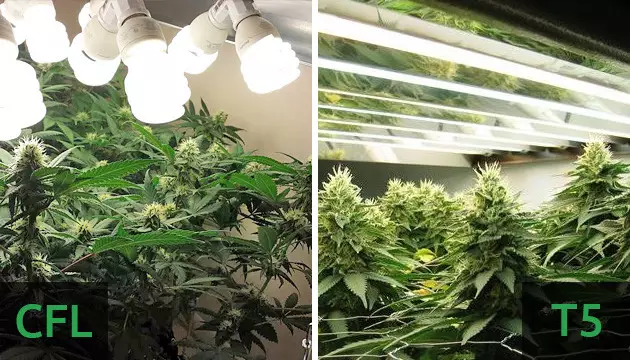
CFL Grow Lights
Chances are you’ve seen CFLs many times before. They’re those curly-shaped bulbs you can find alongside all sorts of other lighting options. While not especially novel, CFLs are great for tiny growing spaces in which heftier lights wouldn’t fit. With the help of a few CFLs, you can even grow cannabis inside a cabinet!
T5 Grow Lights
Compared to CFLs, T5s are a little more cannabis-specific. In fact, T5 grow lights are one of the most popular types out there, as they’re used for everything from cannabis to basil and tomatoes – and they’re available at both the garden store and the grow store.
As the name implies, T5 grow light panels contain 5 bulbs — specifically, 5 long and cylindrical bulbs that stretch the whole length of the panel. Even with their larger size, T5s can be placed very close to your plants without any risk of burn. They’re also great for small-scale grows.
Fluorescent light: the pros
- Great for growing in small areas
- Can be placed close to plants
- Affordable electricity
- Affordable to buy
- Easy to replace
Fluorescent light: the cons
- Generic
- Must be kept close to plants
- Not strong enough to support flower
- Lower cannabis yield per watt (only ¼ gram per bud for every watt spent)*
- Low canopy-penetrating power
HID | High Intensity Discharge Grow Lights
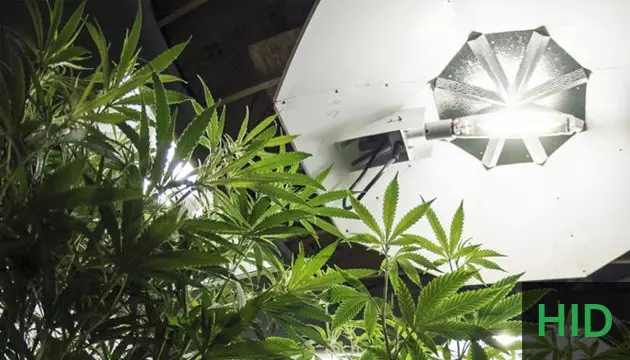
Compared to fluorescents, HID lights are ultra-powerful and highly efficient. HIDs have large and highly recognizable bulbs that are usually encased in a reflective hood to “angle” maximum light back to the plants.
While HID grow lights are easy to set up and amazing for growing cannabis, they can also be amazingly high maintenance. They require exhaust systems to keep cool and may also feature heavy ballasts. While each type of HID is different, they do share some common pros and cons.
HID grow lights: the pros
- Low start-up cost
- Good canopy coverage
- High yields, generally high-quality buds
HID grow lights: the cons
- Need to be kept away from plants, which may require high ceilings
- Consumes lots of electricity
- Bulbs are high maintenance
- Ballasts, reflectors, vents needed
The Three Types Of HID Lights
There are three major types of HID grow lights: metal halide, high-pressure sodium and ceramic metal halide. Let’s move on to take a look at each of these three types of HIDs in more detail.
MH | Metal Halide
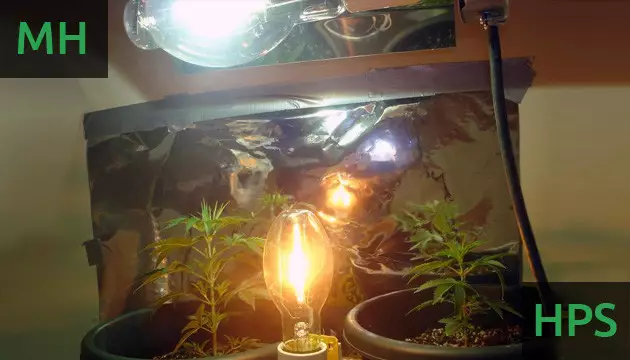
Metal halides focus on only one thing — providing light to plants in vegetative mode — but they do it well. Metal halides are also great for providing light to sensitive clones. Their light spectrum is a little unique and appears bluish to the naked eye. While metal halide grow lights can support a cannabis plant all the way to flower, there are much better choices for this out there, and many growers opt to give their plants a combination of metal halide and HPS-sourced light to round out the lighting spectrum.
HPS | High-Pressure Sodium

High-pressure sodium has been the veritable gold standard for cannabis growers for over 30 years. The reason? HPS lights saturate the cannabis plant canopy more fully than any other type of light out there. Their power practically guarantees thick colas and dense nugs. On the flipside, the power of high-pressure sodium lights necessitates a large growing space and plenty of well-ventilated air.
Another plus? HPS lights are practical. Their pleasant yellow color is both great for plants and easy on the eyes when working under them.
Some growers take things to the next level by alternating HPS and LED lighting throughout the flowering cycle. Anecdotal reports say this method gives plants a true-to-nature terpene profile, just like what you’d get from the sun.
High-pressure sodium: the pros
- Proven results of up to 1 gram/watt!
- Highly efficient
- Easily scalable
- Easy to operate
- Less height adjustment necessary
- Reasonable electricity usage
High-pressure sodium: the cons
- Medium start-up costs
- Difficult to source
- Large grow space is a must
- Exhaust systems needed
CMH | Ceramic Metal Halide
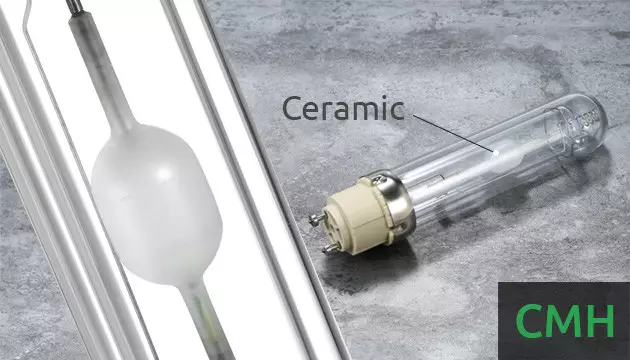
Though not quite as efficient as high-pressure sodium, ceramic metal halide grow lights are a significant step up from regular halides. CMHs can be used throughout a plant’s entire lifecycle, from seed to harvest, without much loss in yield. Talk about practical!
Ceramic metal halides give off a soft, natural color that’s much more pleasant than that of their predecessor. They also produce more light per watt. Some growers believe ceramic metal halides are the light of the future. They provide a full spectrum of natural light, even producing UV-B rays just like the sun, which can mean good things for your plant’s resin production. One thing to note here is that CMHs are sometimes called LECs (light-emitting ceramic) — they’re the same thing, although the term LEC is trademarked.
LED Grow Lights 101
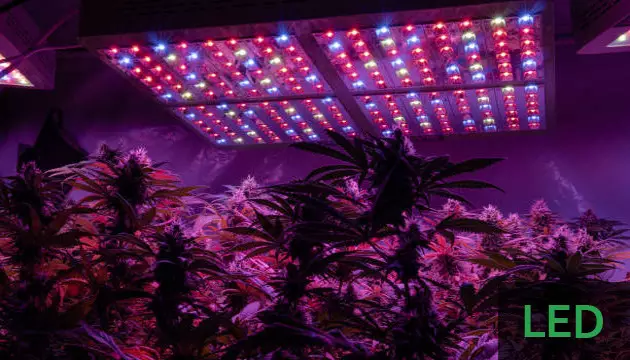
By all appearances, LED grow lights are today’s best option. There’s no more technologically advanced type of grow lamp currently available! LEDs make growing on autopilot easy — they support dimmers, timers, and special veg/flowering modes. Many LED’s are even self-cooling.
It’s therefore no surprise that LEDs are slowly stealing the spotlight away from high-pressure sodium lights. Compared to HPSs, LEDs are cooler and require less maintenance.
Getting started is easy — just hang an LED above your plants and start growing! No expensive ventilation system required.
LED grow lights: the pros
- Built-in cooling system makes ventilation a literal breeze
- May produce more resinous bud than other lights
- Available in super-high wattage options (especially when combined with HPSs)
- Don’t always require ballasts
LED grow lights: the cons
- Average yield per watt is slightly lower than with HPSs — usually around .5g/watt
- LED light categories can be confusing
- Light must be kept high above plants
- High cost
What To Consider When Choosing LEDs
While LED grow lights are awesome, there’s still a lot to consider when choosing the one that’s right for you. Everything from “starter-style” small LEDs to super-powerful 1000-watt lights are available — the choices can be endless! Then there’s the fact that LEDs are continuously getting better. We’ll take a more in-depth look at these factors below.
One important thing to keep in mind is an LED grow light’s PAR value. This value basically measures the amount of usable light emitted. Interestingly enough, cannabis plants produce different compounds at different PAR levels. Some modern LEDs use special lenses to hone in on the specific PAR levels that are best for plants. Lights with this capability are referred to as targeted spectrum.
Other LED suppliers opt for a full spectrum option. Many LED grow lights contain two or more visible colors, designed to provide cannabis plants with everything the sun does so they can grow to be dense and strong. Make sure your LED grow light contains at least a little bit of green and/or white light; green light, in particular, may speed up a plant’s vegetative growth. Green light also has practical benefits, allowing growers to observe plants in their natural state rather than ‘tinted’ by blue or red LEDs.
The many types of LEDs
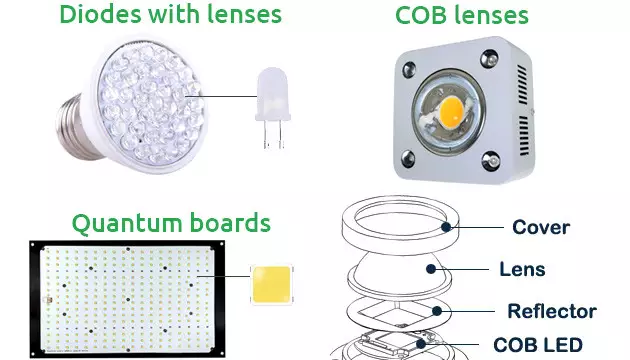
There are three primary types of LED lights used for growing cannabis: diodes with lenses, COB lenses and quantum boards. Depending on your growing goals, any of the three could be best for you!
That said, quantum board-style LEDs have become especially popular lately. Because of their physical shape, these lights can cover a wide canopy of cannabis and provide great results given their low wattage requirements. COB lens LEDs, on the other hand, provide a much more concentrated source of light that’s great for deeply permeating the canopy. Some manufacturers are even making single-light COB LEDs (“AutoCobs”), which can work in even the smallest of growing spaces.
Finally, there are ‘traditional’ LEDs with small lensed diodes spaced along a panel. These are still the most common type of LED grow lights today. Modern panel LEDs often contain a hybridized mix of both small and large bulbs, colors and light spectrums. When it comes to growing cannabis, the more diversity, the better!
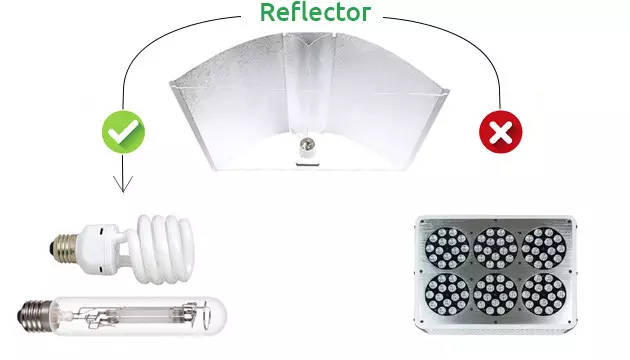
Another plus of LEDs? Unlike the high-pressure sodium gold standard, they don’t require the use of reflectors. Instead, lenses are used to contract and focus an LED’s source of light. Lenses that allow light to project out at a 90-120° angle are (theoretically) the best.
Buyers take note: when it comes to LEDs, purchasing a premium light almost always pays off. Stay away from cheaply-made blue/red LEDs and make sure to get something that’s either full or targeted spectrum! Your crops will thank you for it — and you’ll get a higher ROI. Some specific examples of high-quality lights are coming up next.
From Theory To Practice: The Best Grow Lights On Amazon
To summarize, these days, great grow lights are available from virtually every category. Below is a sampling of some of the best currently available on Amazon.
KINGBO Dual Optical Lens-Series 900W LED:
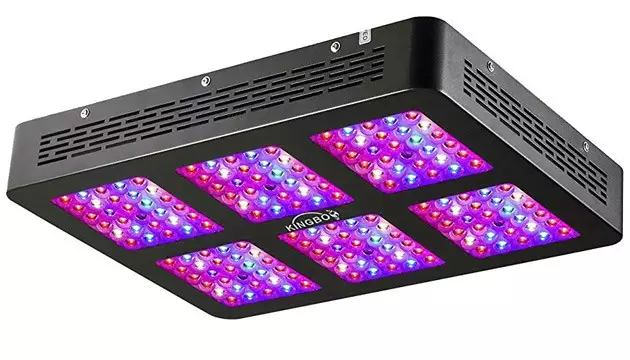
This light is seriously powerful, capable of matching a 1000-watt HPS while itself only consuming 360 watts. It’s easy to operate and can be used for both veg and flower growth cycles. In addition to all that, KINGBO’s light comes with a three-year warranty!
Phlizon 600W LED Plant Grow Light:
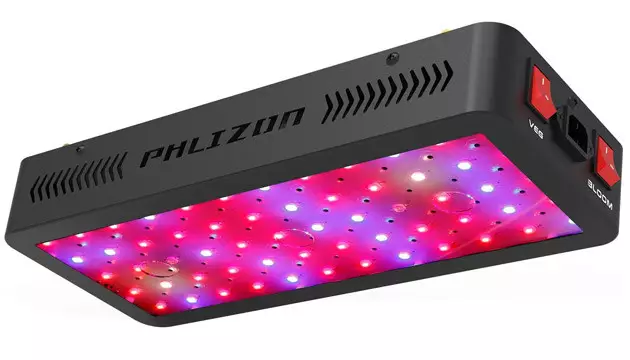
This LED takes a utilitarian approach. Unlike many other lights, Phlizon’s 600W LED uses no reflectors, which the company claims is better for safety. Both veg and bloom modes are available at the flick of a switch, and there’s a two-year warranty.
VIPARSPECTRA 600W LED Grow Light:
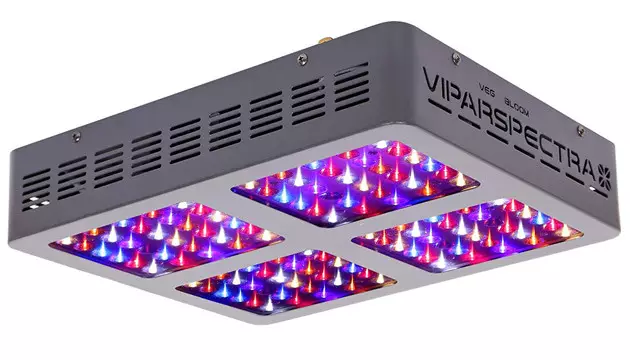
Considering all its features, this VIPARSPECTRA LED is amazingly affordable. It has great PAR value and great canopy coverage to provide your plants with everything they need. VIPARSPECTRA is one of the industry’s most popular brands for a reason!
Wrapping Things Up
These are exciting times to be in the cannabis industry. It used to be that grow lights were expensive, high maintenance and inflexible — but things have really changed! If you’re ready to grow better cannabis than ever before, choose wisely. The grow lights you use could make all the difference.
Herbies Head Shop expressly refuses to support the use, production, or supply of illegal substances. For more details read our Legal Disclaimer.

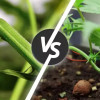

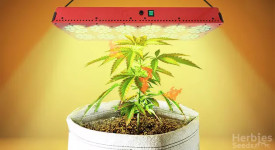
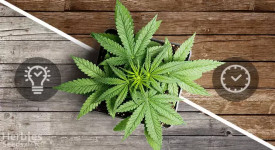
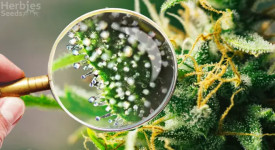

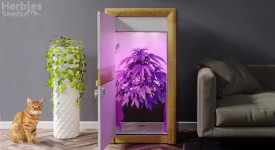



Thank you for leaving a comment for us!
Your feedback will be posted shortly after our moderator checks it.
Please note that we don’t publish reviews that: